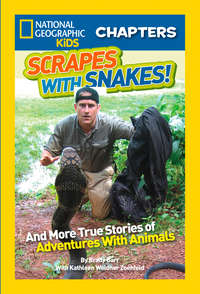
Полная версия
National Geographic Kids Chapters: Crocodile Encounters: and More True Stories of Adventures with Animals

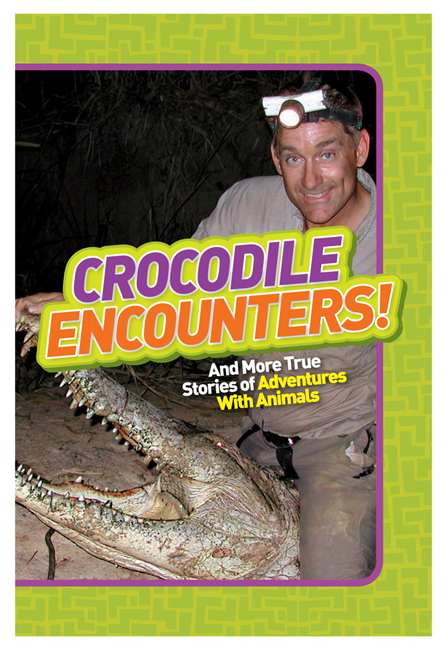
Copyright © 2012 National Geographic Society
All rights reserved. Reproduction of the whole
or any part of the contents without written
permission from the publisher is prohibited.
Published by the National Geographic Society John M. Fahey, Jr., Chairman of the Board and Chief Executive Officer Timothy T. Kelly, President Declan Moore, Executive Vice President; President, Publishing and Digital Media Melina Gerosa Bellows, Executive Vice President; Chief Creative Officer, Books, Kids, and Family
Prepared by the Book Division Hector Sierra, Senior Vice President and General Manager Nancy Laties Feresten, Senior Vice President, Editor in Chief, Children’s Books Jonathan Halling, Design Director, Books and Children’s Publishing Jay Sumner, Director of Photography, Children’s Publishing Jennifer Emmett, Editorial Director, Children’s Books Eva Absher-Schantz, Managing Art Director, Children’s Books Carl Mehler, Director of Maps R. Gary Colbert, Production Director Jennifer A. Thornton, Director of Managing Editorial
Staff for This Book Becky Baines, Laura F. Marsh, Project Editors Lori Epstein, Illustrations Editor Eva Absher-Schantz, Art Director YAY! Design, Designer Grace Hill, Associate Managing Editor Joan Gossett, Production Editor Lewis R. Bassford, Production Manager Susan Borke, Legal and Business Affairs Kate Olesin, Assistant Editor Kathryn Robbins, Design Production Assistant Hillary Moloney, Illustrations Assistant
Manufacturing and Quality Management Phillip L. Schlosser, Senior Vice President Chris Brown, Vice President, NG Book Manufacturing George Bounelis, Vice President, Production Services Nicole Elliott, Manager Rachel Faulise, Manager Robert L. Barr, Manager

For more information, please call
1-800-NGS LINE (647-5463) or
write to the following address:
National Geographic Society
1145 17th Street N.W.
Washington, D.C. 20036-4688 U.S.A.
Visit us online at nationalgeographic.com/books
For librarians and teachers: ngchildrensbooks.org
More for kids from National Geographic:
kids.nationalgeographic.com
For rights or permissions inquiries, please
contact National Geographic Books
Subsidiary Rights: ngbookrights@ngs.org
eISBN: 978-1-4263-1030-0
v3.1
Version: 2017-07-07
Table of CONTENTS
Cover
Title Page
Copyright
UNDERCOVER CROC
Chapter 1: Croc Disguise
Chapter 2: Dangerous Mission
Chapter 3: Joining the Club
TOY STORY
Chapter 1: A Plan to Catch a Croc
Chapter 2: The Great Chase
Chapter 3: Lost and Found
THE DEEP DARK DEN
Chapter 1: Draining the Lake
Chapter 2: What’s in There?
Chapter 3: Beware of Dark Holes!
CROC IN A BOX
Chapter 1: Croc on a Plane?
Chapter 2: Call That Croc In!
Chapter 3: Escape Artist
DON’T MISS!
More Information
Dedication
Credits
Acknowledgments
UNDERCOVER CROC
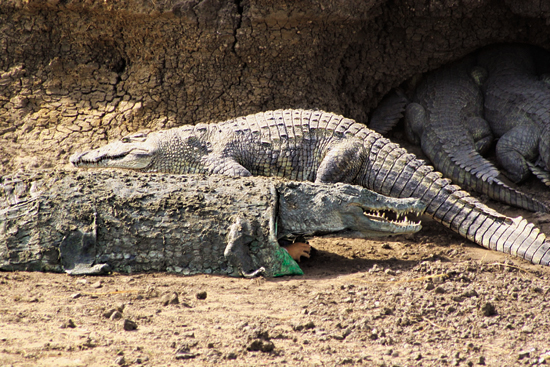
That’s me, zoologist Brady Barr, dressed in a special crocodile suit. My disguise let me get close to the crocs and collect information.
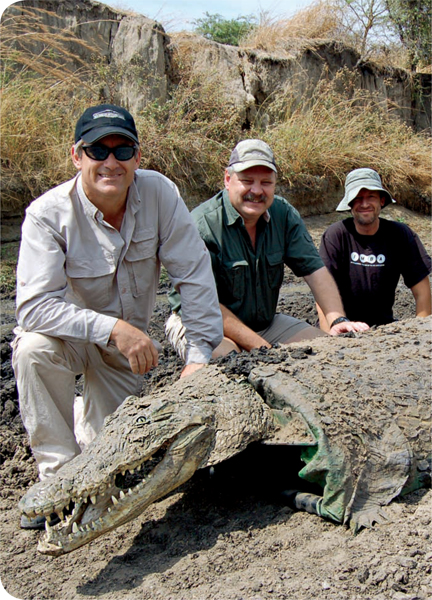
My team and I are ready for our dangerous mission in Tanzania.
Chapter 1
Croc DISGUISE
Hi, my name is Brady Barr, and I’m a zoologist. That means I study animals. I’ve studied all kinds of animals in about 70 countries on Earth. But of all the animals I’ve worked with, crocodiles are my favorite.
There are 23 different types, or species, of crocodilians (sounds like krah-koh-DIL-ee-uhns). I’ve had the chance to see them all in the wild. I’ve been up close to the wide-snouted alligators and caimans (sounds like KAY-mens). I’ve been nose-to-nose with the narrow-jawed crocodiles. And I’ve even studied the weird and wonderful gharial (sounds like GAR-ree-uhl).
Sometimes I have to catch wild crocodiles for my work. For some studies, my team and I need to weigh and measure crocs. For other studies, we need to attach high-tech devices to the crocs. These devices help us keep track of the crocs, or they record information about changes in the areas where the crocs live.
The number of people on Earth is growing every year. More humans on the planet means people need more space. People are moving into areas that were once the wild homes, or habitats, of crocs. With their habitats shrinking, many species of crocodilians are dying out. When a species is dying out, we say it is an endangered species.
The more we know about endangered species and what they need, the better we can help them. But catching wild crocs is a dangerous job—for me and for the crocs!
To catch a croc, I usually have to snare it with a rope. Then I wrestle it until it is very tired. I jump onto its back and tie its jaws shut so it can’t bite. Then I tie its legs. That’s a lot easier said than done!
Even a tired crocodile is very strong. Catching one can turn dangerous quickly. Crocodiles are not used to having people jump on their backs. It is strange for them.
Endangered Crocs
About one-third of all croc species are endangered. In fact, many are among the most endangered animals on the planet. The Philippine crocodile used to live in lakes and rivers throughout the Philippines (sounds like FILL-ih-peens). Today it is only found in a few areas. As the number of humans has grown, more and more of its wild habitat has been turned into farmland.
Loss of habitat has driven the Philippine crocodile almost to extinction. Once a species is extinct, it’s gone forever.
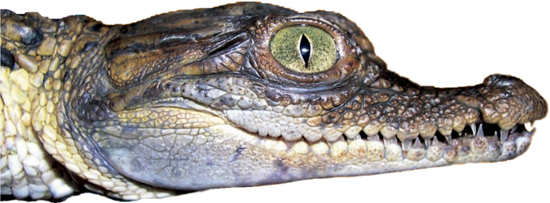
That’s why I am always looking for better ways to handle the crocs and get the information we need.
We know that crocodiles are calmer around other crocs than around humans. If only another croc could find out what we need to know. Then it wouldn’t be so hard on the animal we want to study.
Well, on a trip to Tanzania (sounds like Tan-zan-EE-uh), I got to find out what it feels like to be a croc.
It all started when I was giving a talk to a group of children at their school. I was telling them about my work with crocodiles. One small boy raised his hand.
“Dr. Brady,” he asked, “why don’t you dress up as a croc and join their club?”
At the time, I thought that was pretty funny. I laughed and went on with my talk. But I couldn’t shake the idea from my mind. Could it actually work? I wondered. There was one way to find out!
I asked the people at National Geographic if they could build me a lifelike crocodile suit. Luckily, they were up for the job!
Artists made the head from a mold of a real crocodile head. That made it look exactly like the real thing! It was made of a material called polystyrene (sounds like pahl-ee-STYE-reen). It is very lightweight, but strong.
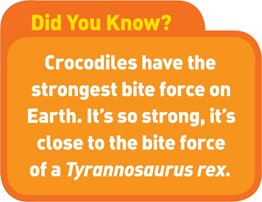
Next, the engineers built the body. This part was important. It needed to protect my body if an angry croc decided to bite!
They made a set of metal ribs. These formed a strong cage around me. Then the cage was covered by a shield made of Kevlar. The same stuff is used to make bulletproof vests. That would make it hard for even a croc bite to break through!
Finally, the artists made a rubber cape that looked just like crocodile skin. This would cover the body and make it look like a real croc.
At last, my croc suit was ready. And boy, did it look real! My plan was to get close enough to a group of wild crocs to put high-tech devices on their backs. If my test was going to work, I would have to make the crocs believe I was one of them.
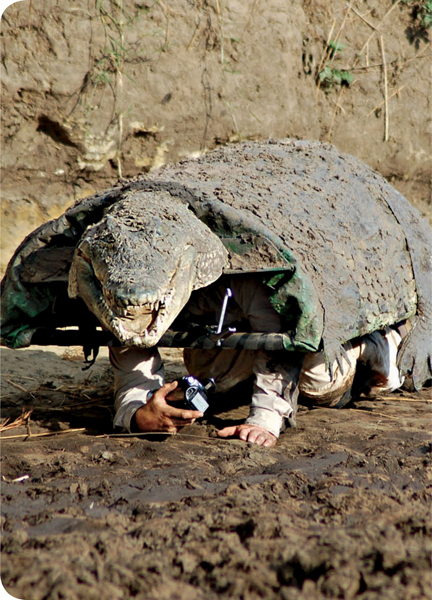
The croc suit was difficult to get around in. It was very heavy and very hot. I could only see straight ahead.
Chapter 2
Dangerous MISSION
A few months later, I was ready to join a bunch of big, wild crocs in Tanzania. I chose Tanzania because it has a lot of crocs. It also has extreme wet and dry seasons.
In the wet season, the crocs spread out over the wetlands. That makes them hard to find.
But in the dry season, the rivers begin to dry up. This creates many separate pools. The crocs are forced to share these shrinking pools. This makes it much easier to find large groups of crocs.
When I got to Tanzania, a fellow scientist was there to help me. His name is Dr. Hannes Botha. He is a croc expert from South Africa.
Hannes and I have worked together many times over the years. We have captured huge crocs together. It is always comforting to work with a friend, someone you know and trust. This is especially true when capturing dangerous animals.
A group of people would help with our experiment. Hannes and I were the two scientists in the group. We also had a wildlife ranger. He would help keep us safe from lions, leopards, and other animals that might want to eat us. And we had two brave National Geographic camera people.
This seemed like a small crew—at least to go after one of the largest predators on the planet: giant Nile crocodiles!
I squeezed my body into the tight suit. The thermometer inside read 120 degrees. I might cook in this suit if I’m inside too long! I thought.
My heart beat faster as I thought of the dangerous crocs a short distance away. There was also a herd of hippos I would have to crawl through to get to the crocs!
Everyone knows crocs are dangerous. What many people don’t know is that the hippo is Africa’s most dangerous animal.
Hippos aren’t meat eaters, but they are very territorial. You don’t want to make them feel threatened if you are on their turf. And if a croc gets too close to a hippo’s baby, watch out! The hippo can bite the croc in half. I would have to stay away from the hippo babies.
Once inside the suit, I felt really sick and really scared. The suit weighed more than 80 pounds. It was very heavy, and I felt very cramped. But the worst part was the smell. We had smeared hippo poop all over it. It was important to cover up my human smell.

Soon it was time to go. My crew stepped back quietly. They hid themselves as well as they could. I started to crawl toward the crocs.
I could only see straight ahead because of my suit. I could not see to the sides or in back of me. But I could talk to my crew using my walkie-talkie. They would warn me if any angry crocs or hippos were moving toward me. It was great to have radio contact with my buddies. I needed to ask them for directions and help. It was good to hear their voices. Then I didn’t feel so alone. It was very scary to be crawling around with danger on all sides.
To get to the crocs, I needed to crawl through the herd of hippos. Hippos can weigh three tons. That’s 6,000 pounds. They can run like the wind. And they don’t welcome intruders.
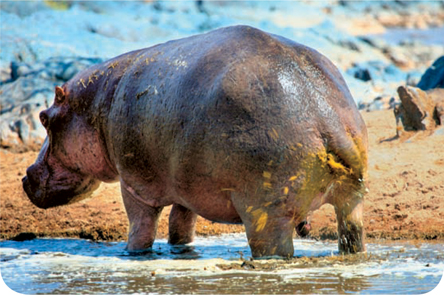
(illustration credits 2.1)
The Scoop on Hippo Poop
Hippos don’t drop their poop like most animals. When a hippo has to go, its tail starts swishing back and forth very fast. Then the hippo lets loose with an explosive shower of poop. It flies through the air and covers everything. It’s called a dung shower.
Hippos do this to mark their territory. One whiff of that dung and you’d want to stay away, too! The hippo dung on my croc suit was so strong, the crocs and hippos couldn’t smell my human smell. It was a good—but smelly—disguise.
I knew the hippos were aware I was there. They were giving me the stare-down. Then I heard them wheeze-honking.
Конец ознакомительного фрагмента.
Текст предоставлен ООО «ЛитРес».
Прочитайте эту книгу целиком, купив полную легальную версию на ЛитРес.
Безопасно оплатить книгу можно банковской картой Visa, MasterCard, Maestro, со счета мобильного телефона, с платежного терминала, в салоне МТС или Связной, через PayPal, WebMoney, Яндекс.Деньги, QIWI Кошелек, бонусными картами или другим удобным Вам способом.


